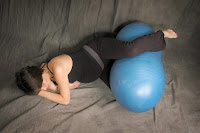Today, expectant parents and childbirth educators alike are faced
with decisions when selecting a birth ball. Should a round or peanut
shaped ball be selected? Should the ball be purchased online, or at a
local discount/fitness store? Should the ball have sand in the bottom to
keep it from rolling around or not? These decisions can be overwhelming.
When selecting a birth ball, the following should be taken into
consideration:
Purpose of the ball:
Round birth balls are great for sitting on. While doing so, the body is in a tripod
position, opening the pelvis and allowing for
potential rotation of the baby's head into a proper position. Additionally, the
"give" of the birth ball makes sitting easier, while the tripod
positioning encourages proper posture (relieving some lower back discomfort in
the pregnant woman). Round birth balls can also be used to lay or lean over
while standing at the side of the bed or even on all fours on a flat surface
such as yoga mat or bed. Being in the all fours position allow the baby
to float out into the sling that the abdominal muscles make, giving the
opportunity to the baby to rotate from a posterior to an anterior birthing
position. Additionally, this position further takes pressure off of the
back during back labor or just the normal discomforts of pregnancy. The Peanut
birth ball has been shown to support the mother in a deeper squat than
the round ball, facilitating the second stage of labor. The Peanut ball
also proves to be effective during epidural anesthesia and has been shown to
significantly reduce the time in labor, while providing comfort for the
laboring woman!Round birth balls are great for sitting on. While doing so, the body is in a tripod
Size of the ball:
The size of the round ball is chosen based on the height of the
laboring mother. Generally, woman who are less than 5' 4" are best
served by a 55 cm ball; women who are less than 5' 9" prefer
the 65 cm ball and those who are taller than 5' 9" should
use a 75 cm ball. The importance is that the legs are at a
right angle when the expectant mother is sitting on the ball
(see photo above).
If the peanut ball is to be used for a supported squat, a 50 cm
ball would be appropriate for an average sized woman, while a 60
cm ball for a taller woman. If used for supporting the leg
during an epidural, 40 cm balls would be appropriate for an
average woman and a 50 cm ball for a larger woman.
Most hospital risk management departments agree that birth balls
should be made of latex-free (to eliminate possible allergic reactions to
latex) and slow deflate material to minimize injury during use.
Additionally, birthing balls should be weight tested to ensure that the
ball will adequately support the user.
Another recent concern in birth ball selection is the addition of
sand in the bottom of birth balls, specifically round ones. While there have
been no research studies to confirm or deny the following factors, anecdotal
information from childbirth educators and doulas were used to make
the list
below.
Factors to consider when deciding to use birth balls with or
without sand include:
- Birth balls with
sand in the bottom reduce the effectiveness of freedom of movement when on
the ball.
- Birth balls with
sand typically have a thinner wall, increasing the likely hood of rapid
deflate if punctured. Birth balls without sand have a thicker layer
of PVC to prevent this from happening.
- Birth balls with
sand add resistance when the pregnant woman gets up from a sitting
position, causing her to possibly be off balance and a fall risk.
Great
care must be taken by the childbirth educator, doula or birth facility in the
selection and purchase of a round or peanut birthing ball.
For further
information, you may contact www.birthsource.com, info@birthsource.com or call
(937) 312-0544 or read The Birth Ball Source Book.



No comments:
Post a Comment